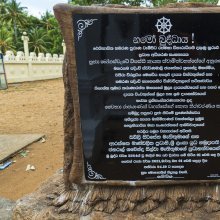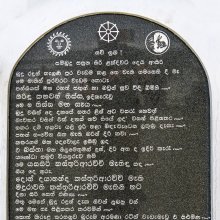Shatara, Satara, Śatāra, Śaṭara: 16 definitions
Introduction:
Shatara means something in Jainism, Prakrit, Hinduism, Sanskrit, the history of ancient India, Marathi, Hindi. If you want to know the exact meaning, history, etymology or English translation of this term then check out the descriptions on this page. Add your comment or reference to a book if you want to contribute to this summary article.
The Sanskrit terms Śatāra and Śaṭara can be transliterated into English as Satara or Shatara, using the IAST transliteration scheme (?).
Alternative spellings of this word include Satar.
Images (photo gallery)
In Jainism
General definition (in Jainism)
Source: Wisdom Library: JainismŚatāra (शतार) refers to a heavenly abode (kalpa) inhabited by Kalpopapanna gods, according to Jain cosmological texts in the Digambara tradition only. The Kalpopapannas (‘those born in the heavens’) represent a sub-species of the Vaimānika gods, which in turn represents the fourth main classification of devas (gods). This kalpa is also known as Śatārakalpa.
Source: Encyclopedia of Jainism: Tattvartha Sutra 4: The celestial beings (deva)Śatāra (शतार) refers to one of the sixteen heavens (kalpa) hosting the sixteen classes of empyrean celestial beings (vaimānika), according to the 2nd-century Tattvārthasūtra 4.19. The living beings residing in the vimānas are called the empyrean gods (vaimānika) and represents one of the four classes of Devas.
What is the number of layers in Śatāra and Sahasrāra heaven pairs? There is one layer there. Which thought-colourations are there in Śukra-Mahāśukra and Śatāra-Sahasrāra gods? They have pink and white thought-colouration. What is the maximum lifespan of deities in Śatāra-Sahasrāra kalpas? It is slightly more than eighteen ocean-measured-periods (sāgara) for both.

Jainism is an Indian religion of Dharma whose doctrine revolves around harmlessness (ahimsa) towards every living being. The two major branches (Digambara and Svetambara) of Jainism stimulate self-control (or, shramana, ‘self-reliance’) and spiritual development through a path of peace for the soul to progess to the ultimate goal.
India history and geography
Source: What is India: Inscriptions of the ŚilāhārasSātārā refers to an ancient country situated above the ghaṭs (east of the Ratnāgiri district) that was under the rule of the Śilāhāra dynasty (r. 765-1029 A.D.).—The country above the ghaṭs, east of the Ratnāgiri District, comprising the modern districts of Sātārā, Kolhāpur, Miraj, Sānglī, and Belgaon. These three countries were divided into smaller divisions and subdivisions for administrative purposes.
Source: Marathi language (Marāṭhī bhāṣā): Submission for Classical Status of Marathi LanguageSatara is the name of a district in Maharashtra.—The Buddhist work, Mahavamsa, refers to Maharashtra. It suggests that a big area around Ujjain, that is, the present Central India could have been talked about as Maharashtra. As the legend goes there were (or might have been) 99,000 villages in this country. These days it is a practice to include all areas (Satara) where Marathi language is in use into Maharashtra.
Source: Cologne Digital Sanskrit Dictionaries: Indian Epigraphical GlossarySa-tara.—(EI 22), see sa-haṭṭa-ghaṭṭa-sa-tara. Note: sa-tara is defined in the “Indian epigraphical glossary” as it can be found on ancient inscriptions commonly written in Sanskrit, Prakrit or Dravidian languages.

The history of India traces the identification of countries, villages, towns and other regions of India, as well as mythology, zoology, royal dynasties, rulers, tribes, local festivities and traditions and regional languages. Ancient India enjoyed religious freedom and encourages the path of Dharma, a concept common to Buddhism, Hinduism, and Jainism.
Languages of India and abroad
Marathi-English dictionary
Source: DDSA: The Molesworth Marathi and English Dictionarysatarā (सतरा).—a Seventeen. satarā pandharā gōṣṭī sāṅgaṇēṃ To utter incoherent speeches; to rant, rave, or prate.
--- OR ---
satāra (सतार).—f ē or ī n ( P) A guitar with three strings.
--- OR ---
sāṭārā (साटारा).—m (sāṭaṇēṃ) A huge pile or mass (as of a house, stack, or other erection).
--- OR ---
sātārā (सातारा).—a C (sātaraṇēṃ, or sa & chatra) Luxuriant with branches and leaves; of rich foliage;-a tree or plant.
Source: DDSA: The Aryabhusan school dictionary, Marathi-Englishsatarā (सतरा).—a Seventeen. satarā pandharā gōṣṭī sāṅgaṇēṃ Utter incoherent speeches, rant, raveprate.
--- OR ---
satāra (सतार).—f A guitar with three strings.
Marathi is an Indo-European language having over 70 million native speakers people in (predominantly) Maharashtra India. Marathi, like many other Indo-Aryan languages, evolved from early forms of Prakrit, which itself is a subset of Sanskrit, one of the most ancient languages of the world.
Sanskrit dictionary
Source: Cologne Digital Sanskrit Dictionaries: Shabda-Sagara Sanskrit-English DictionaryŚatāra (शतार).—n.
(-raṃ) The thunderbolt. E. śata a hundred, ṛ to go, aff. aṇ .
Source: Cologne Digital Sanskrit Dictionaries: Monier-Williams Sanskrit-English Dictionary1) Śatarā (शतरा):—[=śata-rā] [from śata] (śata-) mfn. = -sukha, [Ṛg-veda x, 106, 5; Naighaṇṭuka, commented on by Yāska]
2) Śatāra (शतार):—[from śata] mn. (or tāra) ‘h°-angled’, a thunderbolt, [cf. Lexicographers, esp. such as amarasiṃha, halāyudha, hemacandra, etc.]
3) [v.s. ...] (with Jainas) a [particular] Kalpa, [Dharmaśarmābhyudaya]
4) Satāra (सतार):—[=sa-tāra] [from sa > sa-takṣan] mfn. together with the stars (and ‘with Tārā’), [Harivaṃśa]
5) Satārā (सतारा):—f. Name of a country, [Catalogue(s)]
Source: Cologne Digital Sanskrit Dictionaries: Yates Sanskrit-English DictionaryŚatāra (शतार):—(raṃ) 1. n. The thunder-bolt.
Source: DDSA: Paia-sadda-mahannavo; a comprehensive Prakrit Hindi dictionary (S)Satara (सतर) in the Sanskrit language is related to the Prakrit word: Satara.
[Sanskrit to German]
Sanskrit, also spelled संस्कृतम् (saṃskṛtam), is an ancient language of India commonly seen as the grandmother of the Indo-European language family (even English!). Closely allied with Prakrit and Pali, Sanskrit is more exhaustive in both grammar and terms and has the most extensive collection of literature in the world, greatly surpassing its sister-languages Greek and Latin.
Hindi dictionary
Source: DDSA: A practical Hindi-English dictionarySatara (सतर) [Also spelled satar]:—(nf) a line; row; (a) erect; upright.
...
Prakrit-English dictionary
Source: DDSA: Paia-sadda-mahannavo; a comprehensive Prakrit Hindi dictionarySatara (सतर) in the Prakrit language is related to the Sanskrit word: Satara.
Prakrit is an ancient language closely associated with both Pali and Sanskrit. Jain literature is often composed in this language or sub-dialects, such as the Agamas and their commentaries which are written in Ardhamagadhi and Maharashtri Prakrit. The earliest extant texts can be dated to as early as the 4th century BCE although core portions might be older.
Kannada-English dictionary
Source: Alar: Kannada-English corpusŚatāra (ಶತಾರ):—
1) [noun] the thunderbolt, as the weapon of Indra.
2) [noun] (jain.) the eleventh of the sixteen heavens of jainas.
Kannada is a Dravidian language (as opposed to the Indo-European language family) mainly spoken in the southwestern region of India.
Nepali dictionary
Source: unoes: Nepali-English Dictionary1) Śaṭara (शटर):—n. shutter;
2) Satāra (सतार):—n. a tribe living mainly in Jhapa district of Nepal; the Satar tribe;
Nepali is the primary language of the Nepalese people counting almost 20 million native speakers. The country of Nepal is situated in the Himalaya mountain range to the north of India.
See also (Relevant definitions)
Partial matches: Tara, Sha, Shata, Ca, Ra.
Starts with: Sataranji, Satarasa, Shataraghya, Shatarakalpa, Shataramja, Shataranjabaja, Shataranjabaji, Shataranjini, Shatarashmi, Shataratha, Shataratnasamgraha, Shataratra, Shataratrika.
Ends with: Ashatara, Beshatara, Dashashatara, Parushatara, Peshatara, Ukshatara.
Full-text (+35): Shatarakalpa, Karahata, Satara-mangalyaya, Shataremdra, Miraj, Sahasrara, Lotagada, Dhanakasa, Sa-hatta-ghatta-sa-tara, Dashashatara, Karahada, Satarana, Satar, Peshava, Ambi, Kalpa, Tryambaka, Tripathaga, Vishamapadavyakhya, Belgaon.
Relevant text
Search found 17 books and stories containing Shatara, Sāṭārā, Satāra, Satarā, Satara, Śatāra, Sātārā, Sa-tara, Śatarā, Shata-ra, Śata-rā, Sata-ra, Sa-tāra, Satārā, Śaṭara; (plurals include: Shataras, Sāṭārās, Satāras, Satarās, Sataras, Śatāras, Sātārās, taras, Śatarās, ras, rās, tāras, Satārās, Śaṭaras). You can also click to the full overview containing English textual excerpts. Below are direct links for the most relevant articles:
Tattvartha Sutra (with commentary) (by Vijay K. Jain)
Verse 4.19 - The sixteen Kalpa, nine Graiveyaka and five Anuttara < [Chapter 4 - The Celestial Beings]
Verse 4.22 - Thought-colouration of the fourth class of Deva < [Chapter 4 - The Celestial Beings]
Verse 4.21 - Motion, stature, attachment and pride < [Chapter 4 - The Celestial Beings]
Rig Veda (translation and commentary) (by H. H. Wilson)
Rig Veda 10.106.5 < [Sukta 106]
Bhagavati-sutra (Viyaha-pannatti) (by K. C. Lalwani)
The Skanda Purana (by G. V. Tagare)
Chapter 24 - The Legend of Dharmadatta < [Section 4 - Kārttikamāsa-māhātmya]
Chapter 15 - The Victories of Jalandhara < [Section 4 - Kārttikamāsa-māhātmya]
Gati in Theory and Practice (by Dr. Sujatha Mohan)
Dance movements found in sculptures < [Chapter 4 - Practice of Gati]
Yoga Vasistha [English], Volume 1-4 (by Vihari-Lala Mitra)
Chapter CCVII - Replies to the aforesaid queries (of the buddhist) < [Book VII - Nirvana prakarana part 2 (nirvana prakarana)]

